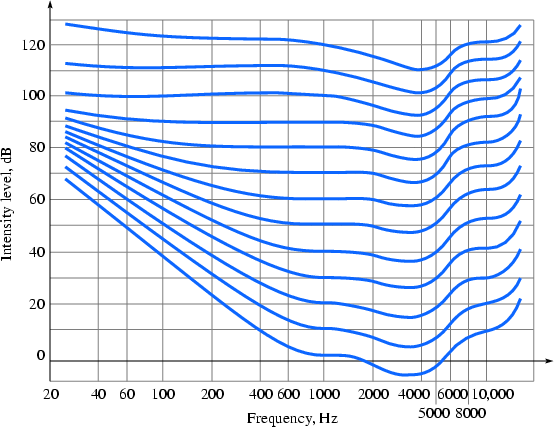 |
| 1 |  | 
If the pressure amplitude of a sound wave is doubled, what happens to the displacement amplitude, the intensity, and the intensity level? |
|  | |
|
|
 |
| 2 |  | 
Many brass instruments have valves that increase the total length of the pipe from mouthpiece to bell. When a valve is depressed, is the fundamental frequency raised or lowered? What happens to the pitch? |
|  | |
|
|
 |
| 3 |  | 
The fundamental frequency of the highest note on the piano is 4.186 kHz. Most musical instruments do not go that high; only a few singers can produce sounds with fundamental frequencies higher than around 1 kHz. Yet a good-quality stereo system must reproduce frequencies up to at least 16 to 18 kHz. Explain. |
|  | |
|
|
 |
| 4 |  | 
Dolphins emit ultrasonic waves with a frequency as high as 2.5 × 105 Hz. What is the wavelength of such a wave in seawater at 25°C? |
|  | |
|
|
 |
| 5 |  | 
Find the speed of sound in mercury, which has a bulk modulus of 2.8 × 1010 Pa and a density of 1.36 × 104 kg/m3. |
|  | |
|
|
 |
| 6 |  | 
During a thunderstorm, you can easily estimate your distance from a lightning strike. Count the number of seconds that elapse from when you see the flash of lightning to when you hear the thunder. The rule of thumb is that 5 seconds elapse for each mile of distance. Verify that this rule of thumb is (approximately) correct. (One mile is 1.6 km and light travels at a speed of 3 × 108 m/s.) |
|  | |
|
|
 |
| 7 |  | 
(a) What is the pressure amplitude of a sound wave with an intensity level of 120.0 dB in air? (b) What force does this exert on an eardrum of area 0.550 × 10-4 m2? |
|  | |
|
|
 |
| 8 |  | 
(a) What should be the length of an organ pipe, closed at one end, if the fundamental frequency is to be 261.5 Hz? (b) What is the fundamental frequency of the organ pipe of part (a) if the temperature drops to 0.0°C? |
|  | |
|
|
 |
| 9 |  | 
A violin is tuned by adjusting the tension in the strings. Brian's A string is tuned to a slightly lower frequency than Jennifer's, which is correctly tuned to 440.0 Hz. (a) What is the frequency of Brian's string if beats of 2.0 Hz are heard when the two bow the strings together? (b) Does Brian need to tighten or loosen his A string to get in tune with Jennifer? |
|  | |
|
|
 |
| 10 |  | 
A source of sound waves of frequency 1.0 kHz is traveling through the air at 0.50 times the speed of sound. (a) Find the frequency of the sound received by a stationary observer if the source moves towards her. (b) Repeat if the source moves away from her instead. |
|  | |
|
|
 |
| 11 |  | 
A boat is using sonar to detect the bottom of a freshwater lake. If the echo from a sonar signal is heard 0.540 s after it is emitted, how deep is the lake? Assume the temperature of the lake is uniform and at 25°C. |
|  | |
|
|
 |
| 12 |  | 
The length of the auditory canal in humans averages about 2.5 cm. What are the lowest three standing-wave frequencies for a pipe of this length open at one end? What effect might resonance have on the sensitivity of the ear at various frequencies? (Refer to Fig. 12.9. Note that frequencies critical to speech recognition are in the range 2 to 5 kHz.)
 <a onClick="window.open('/olcweb/cgi/pluginpop.cgi?it=gif::Fig. 12.9::/sites/dl/free/0070524076/57995/fig_009.gif','popWin', 'width=NaN,height=NaN,resizable,scrollbars');" href="#"><img valign="absmiddle" height="16" width="16" border="0" src="/olcweb/styles/shared/linkicons/image.gif">Fig. 12.9 (269.0K)</a>Fig. 12.9 <a onClick="window.open('/olcweb/cgi/pluginpop.cgi?it=gif::Fig. 12.9::/sites/dl/free/0070524076/57995/fig_009.gif','popWin', 'width=NaN,height=NaN,resizable,scrollbars');" href="#"><img valign="absmiddle" height="16" width="16" border="0" src="/olcweb/styles/shared/linkicons/image.gif">Fig. 12.9 (269.0K)</a>Fig. 12.9 |
|  | |
|
|

